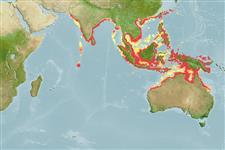Common names from other countries
>
Clupeiformes (Herrings) >
Dorosomatidae (Gizzard shads and sardinellas)
Etymology: Escualosa: Latin, squaleus, squalidus = with rough skin + Latin, alausa = a fish cited by Ausonius and Latin, halec = pickle, dealing with the Greek word hals = salt; it is also the old Saxon name for shad = "alli" ; 1591 (Ref. 45335).
More on author: Valenciennes.
Environment: milieu / climate zone / depth range / distribution range
экология
морской; пресноводный; солоноватоводный; амфидромный (Ref. 51243); пределы глубины 0 - 50 m (Ref. 188). Tropical; 27°N - 22°S, 64°E - 151°E (Ref. 188)
Indo-West Pacific: northern Indian Ocean (Karachi eastward to Rangoon) to Thailand, Indonesia (Java Sea), the Philippines, Papua New Guinea, and Australia.
Length at first maturity / Size / Вес / Возраст
Maturity: Lm ?, range 7 - ? cm
Max length : 10.0 cm SL самец/пол неопределен; (Ref. 188); common length : 8.0 cm SL самец/пол неопределен; (Ref. 188); наибольший возраст (опубликованны данные): 1.00 годы (Ref. 43081)
колючие лучи спинного плавника (общее число) : 0; членистые (мягкие) лучи спинного плавника (общее число) : 13 - 21; колючие лучи анального плавника: 0; членистые (мягкие) лучи анального плавника: 14 - 19. Belly strongly keeled. The almost rectangular second supra-maxilla and the bright silver stripe along the flank distinguish it from juveniles of Sardinella, Amblygaster and Herklotsichthys. Resembles some pellonulines with a silver stripe, but they lack a first supra-maxilla. Distinguished from E. elongata of the Gulf of Thailand but its deeper body and broader silver stripe.
Forms schools in shallow waters, the juveniles apparently entering the lower parts of rivers, but returning later to the sea. Feeds on both zooplankton (copepods, crab zoea, larvae of bivalves and fish eggs) and phytoplankton. Breeds from October to February (mainly November to January) off western coast of India, usually in relatively shallow inshore waters. Marketed fresh and dried-salted.
Whitehead, P.J.P., 1985. FAO Species Catalogue. Vol. 7. Clupeoid fishes of the world (suborder Clupeoidei). An annotated and illustrated catalogue of the herrings, sardines, pilchards, sprats, shads, anchovies and wolf-herrings. FAO Fish. Synop. 125(7/1):1-303. Rome: FAO. (Ref. 188)
Статус Красного Списка МСОП (Ref. 130435)
CITES (Ref. 128078)
Not Evaluated
Угроза для людей
Harmless
Использование человеком
рыболовство: коммерческий
дополнительная информация
инструменты
Специальные отчеты
Скачать в формате XML
ресурсы в Интернет
Estimates based on models
Preferred temperature (Ref.
115969): 26.7 - 29.1, mean 28.4 (based on 1160 cells).
Phylogenetic diversity index (Ref.
82804): PD
50 = 0.7500 [Uniqueness, from 0.5 = low to 2.0 = high].
Bayesian length-weight: a=0.00776 (0.00514 - 0.01173), b=3.05 (2.93 - 3.17), in cm Total Length, based on LWR estimates for this species & (Sub)family-body (Ref.
93245).
Trophic level (Ref.
69278): 3.2 ±0.1 se; based on diet studies.
устойчивость к внешним воздействиям (Ref.
120179): высокий, минимальное время удвоения популяции до 15 месяцев (K=1.82; Fec=7,720; tmax=1).
Fishing Vulnerability (Ref.
59153): Low vulnerability (10 of 100).
